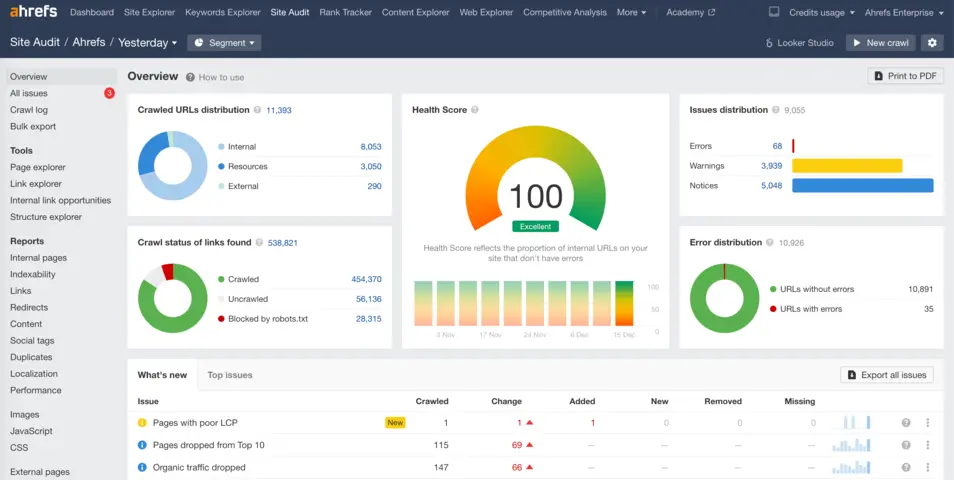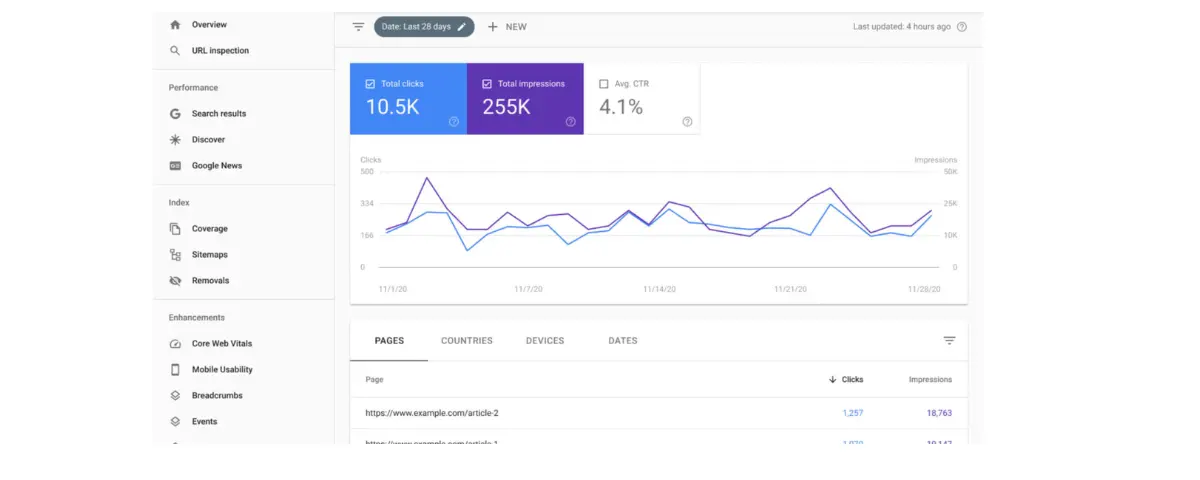Do you feel overwhelmed by the content on your website or blog? Maybe you have old information mixed with new, broken links everywhere, and duplicate pages that are confusing visitors. If this sounds like your situation, it’s time for a content audit.
Don’t worry, it’s just a way to organize your content and see what’s working and what’s not. A good content audit helps you identify what needs improvement and creates a plan to make your content shine.
At Digital Marketing Skill Institute (DMSI), we offer courses that cover various marketing skills to help you succeed in digital marketing, including how to conduct a content audit.
By the end, you’ll have a clear plan to make your website or blog the best it can be.
What is a Content Audit?
A content audit is when you carefully look at and analyze all the content on your website. This includes things like blog posts, product pages, and any other information you have published online. The goal is to figure out what’s working well, what needs to be improved, and where you have opportunities to create new content that will help your business grow.
As a small business owner, you must conduct a content audit to evaluate the effectiveness of your content in achieving your overall business objectives. This audit helps identify which content pieces are driving desired outcomes and which ones are not performing as expected.
Get 50% Discount to Master ALL Aspects of Digital Marketing That Can Earn You $2,500 - $5,000 a month (Even if you are a complete beginner!)
Our students that intentionally implement what they learn from our digital marketing course make back the entire course fee within a single month or more after completing our course because our course gives them many income generating options with unlimited earning potential with no age or location barrier. The best part is no technical skills are required.
An opportunity to change your lifestyle and make money working from anywhere in the world. The results our students get from our digital marketing course prove this could be applied to any market or country and that it is designed for any skill level and work background.
*By signing up, you agree to our privacy policy and terms of service.
For instance, if you run a business that provides SEO (Search Engine Optimization) services, conducting a content audit would entail reviewing all the content on your website – including blog posts, product/service pages, landing pages, and any other written material – to identify areas of improvement and optimize it for better search engine rankings and user engagement.
The goal of a content audit is to help you understand your website’s content and identify ways to improve its quality, relevance, and performance.
Why Do You Need a Content Audit?
Conducting a content audit is crucial to ensure your content aligns with your business goals and resonates with your target audience. It helps you identify areas for improvement and optimize your content marketing strategies to better serve your audience.
Below are some reasons you should prioritize conducting a content audit:
Improve Content Performance
When you assess the effectiveness of your current content, you can pinpoint which pieces are getting the desired results and which ones are falling short. This analysis will enable you to make informed choices about enhancing, merging, or deleting content to boost overall performance.
Identifying Unused Content
When you conduct a content audit and you find unused content, you have the opportunity to repurpose or remove such content. This will help to reduce clutter and ensure that all content is purposeful and aligns with business objectives.
Matching Customer Needs
A content audit offers valuable insights into how well your current content matches the requirements of your target audience. It will help you determine if the content adequately addresses the challenges and preferences of the customers. If not, you can then customize your content to better cater to your customers’ needs.
Enhance SEO Performance
Search engine algorithms are continuously changing, and strategies that were successful in the past may no longer be as effective. Conducting a content audit can help identify areas where your content is not optimized for important keywords or lacks the appropriate structure for search engines to interpret it.
Increase User Engagement
Your content must be both search engine-friendly and engaging for your audience. An audit helps identify underperforming content, such as outdated or poorly formatted content and provides insights to boost engagement and conversion rates.
Benefits of Content Audit
A content audit can provide numerous advantages for your business. Thereby, enabling you to enhance your digital marketing strategies and boost your business’ online visibility. Some of the benefits of performing a content audit.
It helps to Maximize Conversion Rate
Regularly conducting an SEO content audit is crucial to keep your content up-to-date, relevant, and optimized for better conversion rates. This process enables you to optimize existing content and make necessary adjustments to improve conversions.
It will lead to better Website Performance
When you use Semrush, you can identify content gaps when you conduct a content audit, which will lead to optimizing your website conversion rates. When your content is current and relevant, it will improve website performance and enhance user experience.
It will enhance SEO and Organic Search Rankings
When you make it a habit to regularly review website content, it can boost organic search engine rankings and conversion rates. This will help you to identify and fix content issues, such as poor organization, outdated content, or lack of mobile-friendliness. This helps optimize your content for better visibility and search engine effectiveness, making it easier for customers to find your business.
How to Conduct an SEO Content Audit
As a business owner, if you feel that your website content is not performing well in terms of SEO, you are not alone. Many small businesses face challenges in maintaining fresh, optimized, and well-ranking content.
However, there is no need to worry! An SEO content audit is a valuable tool for enhancing your content strategy and improving your online visibility.
Below is a step-by-step outline of how you can perform an SEO content audit for your business:
1. Set Your Goals and Metrics
Before starting your content audit, it’s crucial to define your goals and the metrics you’ll use to measure success. Ask yourself questions like:
- What do I want to achieve with this audit? (e.g., improve SEO, increase engagement, boost conversions)
- How will I know if the audit was successful? (e.g., higher search rankings, more traffic, better conversion rates)
When you clearly define your goals and metrics, this will help guide your audit process and ensure you’re focusing on the right areas.
But for now, you can just make a copy of this SEO content audit template to guide you through the process.
2. Gather Relevant Website Content
The next step is to gather all your website’s content into an inventory. This can be done manually by listing out each page’s URL, title, and other relevant details.
You start by making a list of all the content on your website. This includes blog posts, product descriptions, landing pages, and any other text-based content you have. Alternatively, you can use a free tool like Screaming Frog to crawl your site and generate an inventory automatically for a website with fewer pages.
But for a website with many pages, you need a tool like Semrush, Ahref, or Ubersuggest for the Site Audit. This will save you time and find your pages automatically.
No matter which tool you choose to use, make sure to export your data into a spreadsheet. Include relevant data points such as word count, meta description, target keyword, number of images, etc.
Additionally, consider adding traffic data from Google Analytics to each page so that you can analyze content performance in conjunction with technical SEO metrics.
3. Analyze Performance

The next step is to analyze the data. You can use website analytics tools such as Google Search Console and Google Analytics 4 to evaluate the performance of each piece of content. Consider the following:
- Duplicate Content: Search engines give priority to new and updated content. If you have duplicate content spread across various pages or posts, it will recommend to either delete or rewrite those pages.
- Content Gaps: Check if anything is missing in your content. Are there any topics that you have not addressed yet? Have you reached all of your target markets? Taking a comprehensive look at your content can help you identify any gaps that need to be filled.
- Outdated Content: Individuals are generally not interested in reading outdated content, and search engines also tend to ignore it. It is important to regularly update content wherever possible to ensure it remains relevant and engaging.
- Organic Traffic: Which pages are drawing in the most organic visitors?
- Image: Are all images provided with a descriptive title and alt tag? This practice will enhance the SEO performance and accessibility of your images.
others
- Word Count: Are your pages and posts optimized for SEO with enough words? Ensure that the word count is sufficient and consider updating or editing them if they are too short. Keep track of everything by creating a note.
- Metadata: Did you write metadata descriptions for all pages?
- Engagement Metrics: Are users staying on your content, or is there a high bounce rate (people leaving quickly)?
- Keyword Rankings: How well are your pages ranking for relevant keywords?
The truth is you need to go beyond the traffic numbers and evaluate the general quality of your content. Is it informative, current, and well-written? Does it cater to the needs of your target audience? Check for outdated information, broken links, and content that can be updated and enhanced for better readability.
4. Filter and Label Your Data
So based on your analysis, categorize your content into different buckets:
- Keep and Optimize: High-performing content with good engagement can be further optimized with relevant keywords and improved formatting.
- Refresh and Repurpose: Content with potential but lacking performance can be refreshed with new information and repurposed into different formats (e.g., blog posts to infographics, or social media posts).
- Remove or Redirect: Content that’s outdated or irrelevant can be removed or redirected to more valuable pages on your website.
This will help you prioritize your efforts and keep track of which content needs attention.
5. Perform Content Audit Actions
Now that you’ve identified areas for improvement, it’s time to put your plan into action. You have to start by prioritizing your tasks based on importance and urgency.
Make sure you focus on the most critical issues first, such as fixing broken links or updating outdated content. Break down larger tasks into smaller, manageable chunks, and assign them to specific team members of your team.
Set deadlines and track your progress to ensure you stay on track. With a clear plan in place, you’ll be well on your way to a more effective and engaging content strategy.
6. Regularly Review and Refine
It is important to conduct content audits regularly to ensure that your website’s content stays relevant and supports your business goals. Plan to conduct content audits regularly, ideally at least once a year, to ensure your content remains fresh, relevant, and effective. As you conduct more audits, you’ll be able to refine your process and identify areas for continuous improvement.
If you are still feeling overwhelmed on how to go about doing the content audit, register for this free digital marketing training to gain valuable insights on content marketing and SEO strategies to help grow your business.
Many business owners and marketers have already benefited from it.
Content Audit Tools
You can perform a simple content audit manually using spreadsheets and website analytics. However numerous SEO content audit tools can streamline the process and offer more comprehensive insights. The most suitable content audit tool for you will vary based on your particular requirements and financial resources.
Some of these tools are free while some are paid. Below are a few options for you to consider:
Free Tools
Google Search Console

This Google free tool will provide you with important information about your website’s organic traffic, keyword rankings, and indexing health. It can assist in identifying crawl errors, broken links, and mobile usability issues that may impact the performance of your content.
Price: Free
Google Analytics 4
Google Analytics 4 is a powerful tool that helps you understand how people are interacting with your website. It gives you detailed information about the traffic coming to your site, including which pages are most popular, how long visitors stay, and what they do on your site. This information helps you make informed decisions about your content and how to improve it to better engage your audience.
Price: Free with paid premium options
Screaming Frog
This is another free tool for website crawling. It is an excellent tool for pinpointing technical SEO issues on your site. It is capable of uncovering broken links, crawl errors, and enhancing your website’s meta descriptions and title tags – all of which can significantly impact your content’s SEO effectiveness.
Price: First 500 links free, unlimited for $209/year
Paid Tools
SEMrush
SEMrush is a comprehensive SEO tool that helps you analyze and improve your website’s content. With its content audit feature, you can assess your site’s content, identify potential keywords, track your competitors’ content, and optimize your content for better search engine rankings.

Ahrefs
Ahrefs is a powerful tool that helps you improve your website’s content. Its content audit feature checks your site’s content for issues like broken links, SEO problems, and more. It also suggests ways to enhance your content for better search engine rankings and keyword performance.
As a small business owner just starting, free tools such as Google Search Console and Google Analytics can provide an excellent starting point. So as your business grows and you need more advanced capabilities and in-depth analysis, investing in paid SEO tools like SEMrush or Ahrefs will be beneficial.
Ubersuggest
Ubersuggest is a crucial tool for individuals conducting a content audit to enhance their SEO performance. It streamlines the content audit process by providing actionable insights on enhancing various pages and offering valuable SEO metrics.
Content Audit Template
Performing a comprehensive content audit is essential for achieving success in SEO, however, it can seem overwhelming without the appropriate tools. A content audit template streamlines the process, assisting in organizing and evaluating the performance of your content.
When you use a template, you can pinpoint areas needing improvement, optimize your content, and increase organic traffic to your site. You can use this template. Click on the “Use Template” button at the top right of the page to download it to your Google Drive.
Conclusion
Performing a content audit is not just a routine task; it’s a strategic move that can significantly impact your business’s online success. To achieve this, you must make content audits a regular part of your digital marketing strategy. By doing so, you can consistently improve and enhance your content to better connect with your target audience and drive significant results.
Use the insights gained from your content audit to create content that is engaging, relevant, and effective. This will help you build a strong online presence, attract more visitors, and drive meaningful outcomes for your business.
Are you ready to optimize your website’s content and improve your online presence? Register for our comprehensive digital marketing course and learn how to conduct a successful content audit.
With our practical course, you’ll gain hands-on knowledge and skills to enhance your content, boost engagement, and drive meaningful outcomes for your business.
FAQs
What tools do I need for a content audit?
You can use various tools to conduct a content audit, including Google Analytics, Google Search Console, Screaming Frog, and SEMrush. These tools help you gather data on your website’s traffic, engagement, and search performance, which is essential for identifying areas for improvement.
How do I prioritize my content audit tasks?
Prioritize your content audit tasks based on their impact on your website’s performance and relevance to your target audience. Focus on the most critical issues first, such as fixing broken links or updating outdated content, and then move on to less urgent tasks.
How often should I conduct a content audit?
It’s recommended to conduct a content audit at least once a year, or more frequently if your content is rapidly changing or growing. Regular content audits help you stay on top of your website’s content performance and ensure that your content remains relevant, engaging, and effective in driving results for your business.
Difference between a content audit and SEO?
While a content audit evaluates existing content for quality and relevance, SEO focuses on optimizing content for search engines to improve visibility and ranking.
More Posts
30 Best Content Writing Tools to Improve Your Writing in 2024
10 Types of Media Marketing and How to Utilize Them Effectively
Content Marketing Vs Social Media Marketing: What’s The Difference?





